Thoroughly analyzing AP Inter 2nd Year Physics Model Papers and AP Inter 2nd Year Physics Question Paper May 2018 helps students identify their strengths and weaknesses.
AP Inter 2nd Year Physics Question Paper May 2018
Time: 3 Hours
Maximum Marks: 60
Section – A (10 × 2 = 20)
Note:
- Answer all questions.
- Each question carries two marks.
- All are very short answer type questions.
Question 1.
What is the importance of Oersted’s experiment ?
Answer:
Importance of Oersted’s experiment is every current carrying conductor produces a magnetic field around it and which is perpendicular to current carrying conductor.
Question 2.
The earth takes 24 hours to rotate once about its axis. How much time does the sun take to shift by 1° when viewed from the earth?
Answer:
Time taken for 360° shift = 24 h.
Time taken for 1° shift = \(\frac{24}{360}\) h. \(\frac{24 \times 60 \mathrm{~m}}{360}\) = 4min.
Question 3.
A short bar magnet placed with its axis at 30° with an external field of 800 × 10-4 T experiences a torque of 0.016 Nm. What is the magnetic moment of the magnet?
Answer:
T = MB sin θ
M = \(\frac{T}{B \sin \theta}=\frac{0.016}{800 \times 10^{-4} \times \sin 30^{\circ}}\) =0.4 A – m2
![]()
Question 4.
Define magnetic declination.
Answer:
Magnetic Declination (D) : The angle between the true geographic north and the north shown by a compass needle is called magnetic declination or simply declination (D).

Question 5.
What is the phenomenon involved in the working of a transformer ?
Answer:
When a current changes in one coil magnetic flux changes in it, hence an emf is induced in near coil. This phenomenon is called mutual induction.
Question 6.
Give two uses of infrared rays.
Answer:
- Infrared radiation plays an important role in maintaining the Earthwarm.
- Infrared lamps are used in Physical therapy.
- Infrared detectors are used in Earth Satellites.
- These are used in taking photographs during the conditions of fog, smoke etc.
Question 7.
What is “Photoelectric effect” ?
Answer:
When light of sufficient energy is incident on the photometal surface, electrons are emitted. This phenomenon is called photoelectric effect.
Question 8.
What are “Cathode rays” ?
Answer:
Fast moving electrons are called cathode rays.
Question 9.
What are intrinsic and extrinsic semiconductors?
Answer:
Pure form of semiconductors are called instrinsic semiconductors.
When impure atoms are added to increase their conductivity, they are called extrinsic semiconductors.
Question 10.
Which type of communication is employed in mobile phones?
Answer:
Space wave mode of propagation is employed in mobile phones.
![]()
Section – B (6 × 4 = 24)
Note :
- Answer any six of the following questions.
- Each question carries four marks.
- All are short answer type questions.
Question 11.
Define focal length of a concave mirror. Prove that the radius of curvature of a concave mirror is double its focal length.
Answer:
Focal length of concave mirror :
The distance between the focus F and the pole P of the mirror is called the focal length of the concave mirror. Consider, a ray AB parallel to principal axis incident on a concave mirror at B and is reflected along BF. The line CB is normal to the mirror.
Let θ be the angle of incidence, ∠ABC = ∠BCP = θ
Draw BD ⊥ CP
In right angled Δle BCD

tan θ = \(\frac{B D}{C D}\) ………… (1)
From Δle BFD, tan 2θ = \(\frac{B D}{F D}\) ……….. (2)
Dividing eq (2) by eq (1), \(\frac{\tan 2 \theta}{\tan \theta}=\frac{C D}{F D}\) ……….. (3)
If θ is very small, then tan θ ≈ θ and tan 2θ ≈ 2θ since the aperture of the lens is small.
∴ The point B lies very close to p.
CD ≈ CP and FD ≈ FP
From eq.(3), \(\frac{2 \theta}{\theta}=\frac{C P}{F P}=\frac{R}{f}\) ⇒ 2 = \(\frac{R}{f}\)
R = 2f
Question 12.
Explain Doppler effect in light. Distinguish between red shift and blue shift.
Answer:
Doppler effect in light: The change in the apparent frequency of light, due to relative motion between source of light and observer. This phenomenon is called Doppler effect.
The apparent frequency of light increases when the dis- tance between observer and source of light is decreasing and the apparent frequency of light decreases, if the distance between source of light and observer increasing.
Question 13.
State and explain Coulomb’s inverse square law in electricity.
Answer:
Coulomb’s law: “The force of attraction (or) repulsion between two charges is directly proportional to the product of their charges and inversely proportional to the square of the distance between the charges”.
Explanation: Let two point charges q1 and q2 separated by a distance r in air. According to Coulomb’s law, the force between two charges is given by
i) F ∝ q1q2
∴ F ∝ \(\frac{\mathrm{q}_1 \mathrm{q}_2}{\mathrm{r}^2}\)
F = \(\frac{1}{4 \pi \varepsilon_0} \cdot \frac{\mathrm{q}_1 \mathrm{q}_2}{\mathrm{r}^2}\)
ii) F∝ \(\frac{1}{\mathrm{r}^2}\)
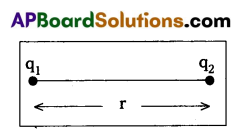
where \(\frac{1}{4 \pi \varepsilon_0} \cdot \frac{\mathrm{q}_1 \mathrm{q}_2}{\mathrm{r}^2}\) = 9 × 109 Nm-2C-2 = Proportionality constant
ε0 = 8.854 × 10-12 C2N-1 m = Permittivity in free space.
![]()
Question 14.
A 900 × 10-12 F capacitor is charged by 100 V battery. How much electrostatic energy is stored by the capacitor?
Answer:
Given, C = 900 × 10-12F; V = 100v
Energy stored in the capacitor
U = \(\frac{1}{2}\) CV2 = \(\frac{1}{2}\) × (900 × 10-12) (100)2
∴ U = 450 × 10-8 J
Question 15.
Describe the ways in which Eddy currents are used to advantage.
Answer:
Eddy currents are used to advantage in
i) Magnetic breaking in trains : A strong magnetic field is applied across the metallic drum rotating with the axle of the electric train. Thus large eddy currents are pro- duced in the metallic drum. These currents oppose the motion of the drum and hence the axle of the train which ultimately makes the train come to rest.
ii) Induction Motor: Eddy currents are used to rotate the short circuited rotor of an induction motor. Ceiling fans are also induction motors which run on single phase alternating current.
iii) Electromagnetic damping: Certain galvanometers have a fixed core made of non magnetic metallic material. When the coil oscillates, the eddy currents generated in the core oppose the motion and bring the coil to rest quickly.
iv) Induction furnace Induction furnace can be used to produce high temperatures and can be utilised to prepare alloys, by melting the constituent metals. A high frequency alternating current is passed through a coil. The eddy currents generated in the metals produce high temperatures sufficient to melt it.
v) Analogue energy meters: Concept of eddy currents is used in energy meters to record the consumption of electricity. Aluminium disc used in these meters get induced due to varying magnetic field. It rotates due to eddy currents produced in it.
Question 16.
How do you convert a moving coil galvanometer into an ammeter and a voltmeter? Explain with diagrams.
Answer:
Conversion of moving coil galvanometer into ammeter :
1) Moving coil galvanometer is converted into an ammeter by connecting a suitable small resistance or shunt resis- tance in parallel to it.
2) Ammeter is always connected in series.
3) The circuit diagram of conversion of Galvanometer into Ammeter is shown below.
4) In diagram, I is main current, Ig is galvanometer current, Is is shunt current and G, sare resistances of galvanom- eter and shunt.
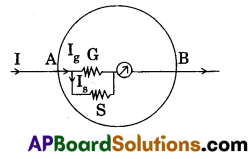
I = Ig(1 + \(\frac{G}{S}\))
Conversion of moving coil galvanometer into voltmeter :
1) A galvanometer is converted into voltmeter by connecting a high resistance (R) in series with it.
2) voltmeter is always connected in parallel to the line.

V = Ig(G + R)
3) The circuit diagram of conversion of galvanometer into voltmeter is shown below.
4) In diagram, Ig is current in galvanometer, Vg is P.D between A and B of main line, Vg is P.D of galvanometer, G is galvanometer resistance and R is high resistance.
Question 17.
Explain the different types of spectral series.
Answer:
The atomic hydrogen emits a line spectrum consisting of five series.
- Lyman series : υ = Rc (\(\frac{1}{1^2}-\frac{1}{\mathrm{n}^2}\)) where n = 2, 3, 4, …….
- Balmer series : υ = Rc (\(\frac{1}{2^2}-\frac{1}{\mathrm{n}^2}\)) where n = 3, 4, 5, …….
- Paschen series: υ = Rc (\(\frac{1}{3^2}-\frac{1}{\mathrm{n}^2}\)) where n = 4, 5, 6, …….
- Brackett series : υ = Rc (\(\frac{1}{4^2}-\frac{1}{\mathrm{n}^2}\)) where n = 5, 6, 7, …….
- Pfund series : υ = Rc (\(\frac{1}{5^2}-\frac{1}{\mathrm{n}^2}\)) where n = 6, 7, 8, ….
![]()
Question 18.
Distinguish between half-wave and full-wave rectifiers.
Answer:
| Half wave rectifier | Full wave rectifier |
| 1. Single diode is used. | 1. Two diodes are used. |
| 2. Only half wave is rectified. | 2. Full wave is rectified. |
| 3. Rectifier efficiency η = \(\frac{0.406 R_L}{r_f+R_L}\) | 3. Rectifier efficiency η = \(\frac{0.812 R_L}{r_f+R_L}\) |
| 4. Efficiency of half wave rectifier is 40.6%. | 4. Efficiency of full wave rectifier is 81.2%. |
| 5. Output is discontinuous and pulsative. | 5. Output is continuous and pulsative. |
Section – C (2 × 8 = 16)
Note:
- Answer any two of the following questions.
- Each question carries eight marks.
- All are long answer type questions.
Question 19.
a) Explain the formation of stationary waves in stretched strings with the help of neat diagram and derive harmonic equations.
Answer:
A string is a metal wire whose length is large when compared to its thickness. A stretched string is fixed at both ends, when it is plucked at mid point, two reflected waves of same amplitude and frequency at the ends are travelling in opposite direction and overlap along the length. Then the resultant waves are known as the standing waves (or) stationary waves.
Let two transverse progressive waves of same amplitude a, wave length λ and frequency ‘v’, travelling in opposite direction be given by
y1 = a sin (kx – ωt) and y2 = a sin (kx + ωt)
where ω = 2π v and k = \(\frac{2 \pi}{\lambda}\)
The resultant wave is given by y = y1 + y2
y = a sin (kx – ωt) + a sin (kx + ωt)
y = (2a sin kx) cos ωt
2a sin kx = Amplitude of resultant wave.
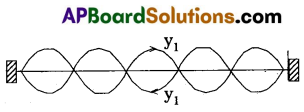
It depends on ‘kx’. If x = 0, \(\frac{\lambda}{2}, \frac{2 \lambda}{2}, \frac{3 \lambda}{2}\) … etc,
the amplitude = zero
These position are known as “Nodes”.
If x = \(\frac{\lambda}{4}, \frac{3 \lambda}{4}, \frac{5 \lambda}{4}\) ……. etc, the amplitude = maximum (2a).
These positions are called “Antinodes”.
If the string vibrates in ‘P’ segments and ‘l’ is its length then length of each segment = \(\frac{l}{\mathrm{P}}\)
Which is equal to \(\frac{\lambda}{2}\)
∴ \(\frac{l}{\mathrm{P}}=\frac{\lambda}{2}\) ⇒ λ = \(\frac{2 l}{\mathrm{P}}\)
Harmonic frequency v = \(\frac{v}{\lambda}=\frac{v P}{2 l}\)
v = \(\frac{v \mathrm{P}}{2 l}\) ………….. (1)
If ‘T’ is tension (stretching force) in the string and ‘μ’ is linear density then velocity of transverse wave (v) in the string is
v = \(\sqrt{\frac{T}{\mu}}\) ……. (2)
From the Eqs (1) and (2)
Harmonic frequency v = \(\frac{\mathrm{P}}{2 l} \sqrt{\frac{\mathrm{T}}{\mu}}\)
If P = 1 then it is called fundamental frequency (or) first harmonic frequency
∴ Fundamental Frequency v = \(\frac{1}{2 l} \sqrt{\frac{\mathrm{T}}{\mu}}\) ………. (3)
If p = 2 then it is first overtone (or) second harmonic frequency.
v1 = \(\frac{2}{2 l} \sqrt{\frac{\mathrm{T}}{\mu}}\)2v
Similarly if p = 3 then second overtone (or) third harmonic frequency.
v2 = \(\frac{3}{2 l} \sqrt{\frac{\mathrm{T}}{\mu}}\)3v
from the Eqs (3), (4) and (5)
The ration of the frequencies of harmonics are
v : v1 : v2 : = v : 2v : 3v = 1 : 2 : 3
∴ The frequencies of the overtones in a given vibrating length, are integral multiples of the fundamental in the same length.
Laws of Transverse Waves Along Stretched String:
Fundamental frequency of the vibrating string v = \(\frac{1}{2 l} \sqrt{\frac{\mathrm{T}}{\mu}}\)
First Law: When the tension (T) and linear density (µ) are constant, the fundamental frequency (v) of a vibrating string is inversely proportional to its length.
∴ v ∝ \(\frac{1}{\mathrm{~T}}\) ⇒ vl constant, when ‘T’ and ‘μ’ are constant.
Second Law: When the length (l) and its, linear density (m) are constant the fundamental frequency of a vibrating string is directly proportional to the square root of the stretching force (T).
∴ v ∝ √T ⇒ \(\frac{v}{\sqrt{T}}\) constant, when ‘l’ and ‘+’ are constant.
Third Law: When the length (1) and the tension (T) are constant, the fundamental frequency of a vibrating string is inversely proportional to the square root of the linear density (M).
v ∝ \(\frac{1}{\sqrt{\mu}}\) ⇒ v√μ constant, when ‘l’ and ‘T’ are constant.
b) A stretched wire of length 0.6 m is observed to vibrate with a frequency of 30 Hz in the fundamental mode. Find the velocity of propagation of transverse waves in the string.
Answer:
Given l = 0.6 m; v = 3H2
Velocity of propagation in the string
v = 2vl = 2 × 30 × 0.6 = 36 m/s
Question 20.
State the working principle of potentiometer. Explain with the help of circuit diagram how the potentiometer is used to determine the internal resistance of the given primary cell.
Answer:
Working principle of potentiometer: The potential difference across a length of the potentiometer wire is directly proportional to its length (or) when a steady current is passed through a uniform wire, potential drop per unit length or potential gradient is constant.
i.e. ε ∝ l ⇒ ε = Φl
where Φ is potential gradient.
Measurement of internal resistance (r) with potentiometer:
- Potentiometer to measure internal resistance (r) of a cell (ε) is shown in diagram.
- The cell (emf ε) whose internal resistance (r) is to be determined is connected across a resistance box (R.B) through a key K2.
- With key K2 open, balance is obtained at length l1, (AN1).
Then ε = Φl1 ……….. (1) - When key K2 is closed, the cell sends a current (I) through the resistance box (R.B).
- If V is the terminal potential difference of the cell and balance is obtained at length l2 (AN2).
Then V = Φl2 ……….. (2) - \(\frac{(1)}{(2)}\) ⇒ \(\frac{\varepsilon}{\mathrm{V}}=\frac{l_1}{l_2}\) ………… (3)
- But ε = I (r + R) and V = IR. This gives
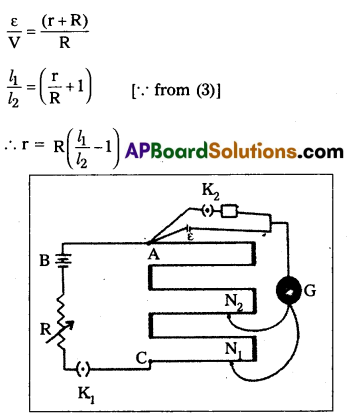
![]()
Question 21.
Explain the principle and working of a nuclear reactor with the help of a labelled diagram.
Answer:
Principle: A nuclear reactor works on the principle of achiev- ing controlled chain reaction in natural Uranium 238U enriched with 235U, consequently generating large amounts of heat.
A nuclear reactor consists of
(1) Fuel
(2) Moderator
(3) Control rods
(4) Radiation shielding
(5) Coolant.
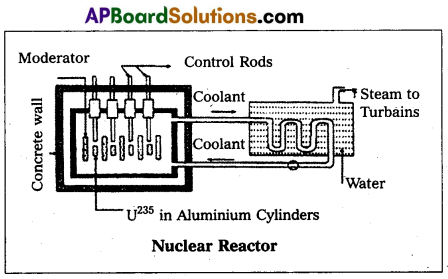
1. Fuel and clad : In reactor the nuclear fuel is fabricated in the form of thin and long cylindrical rods. These group of rods treated as a fuel assembly. These rods are surrounded by coolant, which is used to transfer of heat produced in them. A part of the nuclear reactor which use to store the nuclear fuel is called the core of the reactor. Natural uranium, enriched uranium, plutonium and uranium – 233 are used as nuclear fuels.
2. Moderator: The average energy of neutrons released in fission process is 2.MeV. They are used to slow down the velocity of neutrons. Heavy water or graphite are used as moderating materials in reactor.
3. Control Rods: These are used to control the fission rate in reactor by absorbing the neutrons. Cadmium and boron are used as controlling the neutrons, in the form of rods.
4. Shielding: During fission reaction beta and gamma rays are emitted in addition to neutrons. Suitable shielding such as steel, lead, concrete etc are provided around the reactor to absorb and reduce the intensity of radiations to such low levels that do not harm the operating personnel.
5. Coolant: The heat generated in fuel elements is removed by using a suitable coolant to flow around them. The coolants used are water at high pressures, molten sodium etc.
Working: Uranium fuel rods are placed in the aluminium cylinders. The graphite moderator is placed in between the fuel cylinders. To control the number of neutrons, a number of control rods of cadmium or beryllium or boron are placed in the holes of graphite block. When a few 235U nuclei undergo fission fast neutrons are liberated. These neutrons pass through the surrounding graphite moderator and loose their energy to become thermal neutrons. These thermal neutrons are captured by 235U. The heat generated here is used for heating suitable coolants which in turn heat water and pro- duce steam. This steam is made to rotate steam turbine and there by drive a generator of production for electric power.